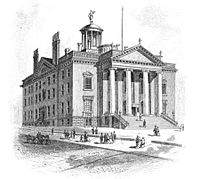35th New York State Legislature
| 35th New York State Legislature | |||||
|---|---|---|---|---|---|
|
|||||

The Old State Capitol (1879)
|
|||||
| Overview | |||||
| Jurisdiction | New York, United States | ||||
| Term | July 1, 1811 – June 30, 1812 | ||||
| Senate | |||||
| Members | 32 | ||||
| President | Lt. Gov. DeWitt Clinton (Dem.-Rep.) | ||||
| Party control | Democratic-Republican (26–6) | ||||
| Assembly | |||||
| Members | 112 | ||||
| Speaker | Alexander Sheldon ((Dem.-Rep.) | ||||
| Party control | Democratic-Republican (66–38) | ||||
| Sessions | |||||
|
|||||
| 1st | January 28 – March 27, 1812 |
|---|---|
| 2nd | May 21 – June 19, 1812 |
The 35th New York State Legislature, consisting of the New York State Senate and the New York State Assembly, met from January 28 to June 19, 1812, during the fifth year of Daniel D. Tompkins's governorship, in Albany.
Under the provisions of the New York Constitution of 1777, amended by the Constitutional Convention of 1801, 32 Senators were elected on general tickets in the four senatorial districts for four-year terms. They were divided into four classes, and every year eight Senate seats came up for election. Assemblymen were elected countywide on general tickets to a one-year term, the whole Assembly being renewed annually.
In 1797, Albany was declared the State capital, and all subsequent Legislatures have been meeting there ever since. In 1799, the Legislature enacted that future Legislatures meet on the last Tuesday of January of each year unless called earlier by the governor.
In 1808, Cattaraugus and Chautauqua counties had been split from Genesee County, but no county governments were organized for some time. In 1811, both counties were joined with Niagara in one Assembly district with 1 seat.
Lt. Gov. John Broome died on August 8, 1810, and a special election was required to fill the vacancy. State Senator and Mayor of New York City DeWitt Clinton was nominated by the Democratic-Republican majority. Nicholas Fish was nominated by the Federalists, and Marinus Willet was nominated by the Tammany organization in New York City which, although being the local affiliate of the Democratic-Republican Party, was opposed to Clinton.
At this time the politicians were divided into two opposing political parties: the Federalists and the Democratic-Republicans.
The State election was held from April 30 to May 2, 1811. DeWitt Clinton was elected Lieutenant Governor of New York.
...
Wikipedia
